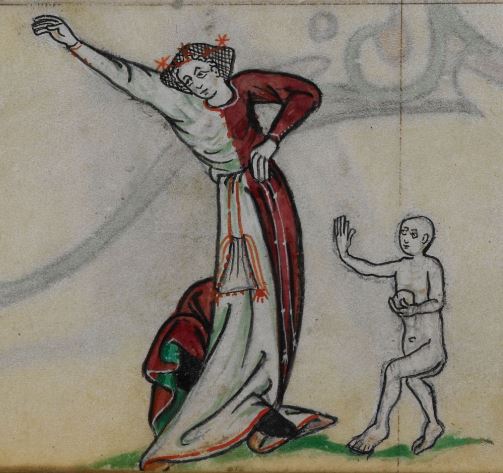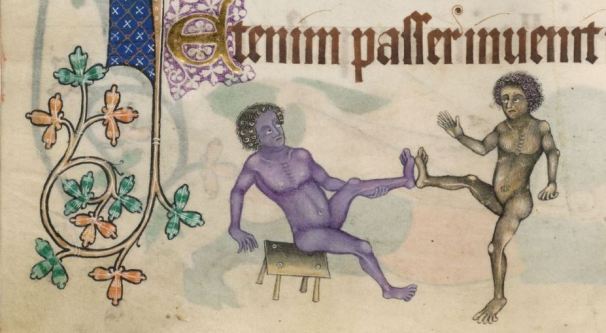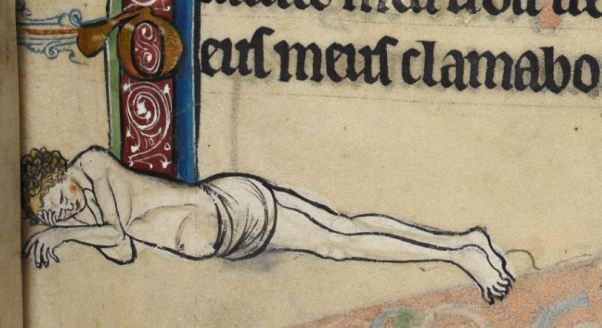Good morning, everyone! Feeling energised today? I’ve been trying to wake myself up in the mornings by doing a little bit of Pilates first thing. Years of sitting at a computer poring over medieval prayers have left me horribly unbendy, so I’ve been taking classes for over a year now in order to get a bit stronger and more flexible.

Many people will tell you that these exercises were invented by Joseph Pilates in the twentieth century, but in fact this is untrue. Manuscript evidence (in the form of what is known as ‘gymnastic decoration‘) suggests to us that an early form of Pilates was practised as far back as the high Middle Ages. In fact, Joseph Pilates borrowed some of his exercises directly from the medieval trailblazers.

So today I will present a guide to Pilates as it was practised throughout the Middle Ages. Please note: I don’t necessarily encourage you to try all of these exercises. Some of them are being performed by very advanced students indeed. And bear in mind that not all of the participants are actually human.
All you need to get started

Although a few simple pieces of equipment are sometimes used in Pilates, all you really need is a mat, as demonstrated by this practitioner in the fifteenth-century Bedford Hours. He is probably preparing to do some single leg circles. Or he’s collapsed from overexertion. The text suggests the latter.
How to begin
These students, depicted in the mid-thirteenth-century Rutland Psalter, will show you how to get started. Standing upon your mat, stretch your right arm upwards and to the right as far as it will go, and swing it around anti-clockwise, bending forward as needed, with your left arm following; circle your left arm up over your head until you reach your starting point. Then do the same again, but in reverse.

Follow this by standing with legs hip-width apart, and slowly bend them while breathing in …

… and as you breathe out, curl your chin towards your chest and roll your spine forward, vertebra by vertebra, reaching your arms downwards, until, if possible, you touch the floor.
Elephant
If you have good flexibility, follow this with the Elephant, an ideal move for stretching your calves and hamstrings. Once you have reached the floor, keep your legs straight and your hips lifted, engage your stomach muscles like this man is doing, and slowly walk forward:

Double side leg lift

To perform a double side leg lift, lie sideways on your mat, hips stacked one on top of the other. Take an in-breath to prepare, and, as you exhale, gently raise both legs; and then lower them again whilst breathing in once more. This exercise is usually undertaken with arm and shoulder support, so this student is clearly very advanced and must be making use of some great core muscle strength. Although having wings probably helps.
Extra equipment

Even in the early days, the routine already included the use of specialist equipment, such as a Pilates ring.

These two men are having to share between themselves, creating extra resistance by pushing against one another. The ingenuity of the medieval practitioners is astounding.
Adjustments for those with tight hamstrings
Some people, like myself, will find that they have a restricted level of flexibility, and that not all Pilates exercises are possible for them.

Depicted in the early fourteenth-century Luttrell Psalter, the man on the right is struggling to raise his right leg parallel to the floor without bending the knee, whereas the one on the left is having difficulties doing even this. In these cases, a small stool may be used to alter the angle of the legs; he is also using his left hand to provide some extra support.

This man is also doing a hamstring stretch, but please note that the use of sheep is NOT recommended.

For advanced practitioners
If you practise medieval Pilates for long enough, you may eventually become as flexible as this woman:

But even the most experienced practitioners sometimes admit defeat.

Enjoy your medieval Pilates!

Works used:
Melissa Cosby, The Pilates Healing Bible (London: Quantum , 2013).
This is absolutely brilliant. Funniest medieval themed post I have read for years. You made my day. Going home now to do some stretches and read about the Franks.
LikeLike
Thank you!
LikeLike
Hilarious. I look forward to sharing this. Betsy Walker #coreAlignPilates, #BetsyWalkerWellness
LikeLike
Thanks!
LikeLike
Hilarious. However that chap breathing in and out – some lines in the drawing suggest he may well be emitting gas from another *cough* orifice.
LikeLike
😀
LikeLike